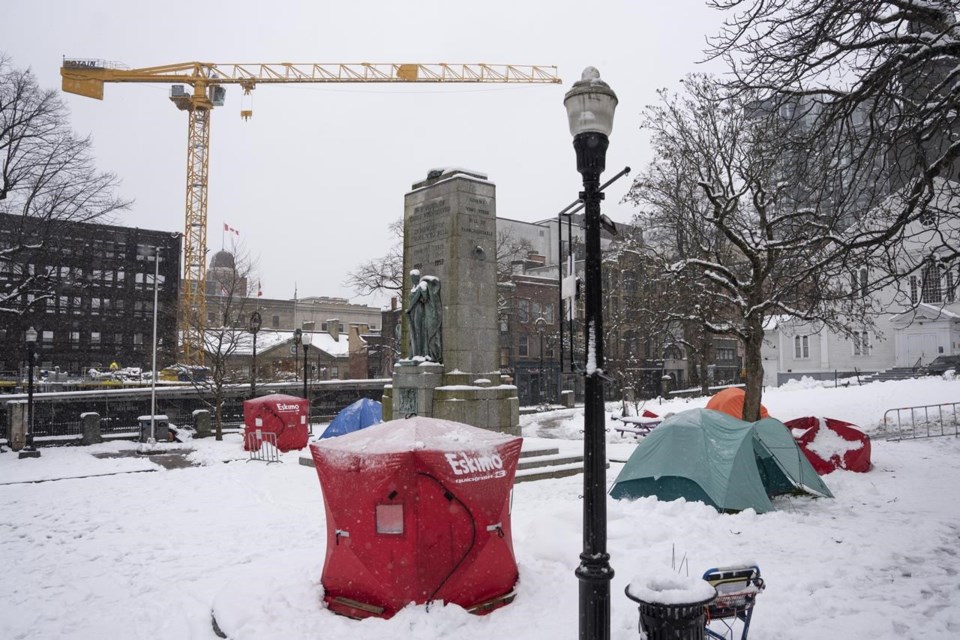FREDERICTON — The various sources of heat used by people living in tents carry a high risk of fire that can threaten lives, say homeless advocates in New Brunswick after a man died in an encampment in Saint John.
Johanne McCullough, director of Street Team Saint John, says some of those heat sources include candles, propane cylinders and butane stoves. A combination of small, enclosed spaces, flammable materials and heat sources can prove to be deadly, she said in an interview Monday.
"It happens more during winter because they're bringing the heat source indoors," she said.
On Saturday, a 44-year-old man died after suffering serious burns in a fire at an encampment located near a highway on-ramp. McCullough said one of her group's volunteers was driving by the encampment at around 8 p.m., saw the flames and called 911.
The Saint John Police Force identified the man on Monday as Peter Evan Ralph McArthur; they said they were investigating the circumstances that led to his death.
Four people were at the encampment when the fire broke out, McCullough said, two of whom spent Saturday night at separate shelters. "They were quite shaken up," she said.
"One person decided to stay there. To that person, we gave blankets and a tent and a sleeping pad." The next night, however, he chose to stay at a shelter.
"I think he puts on a brave face, but I'm sure he's quite affected by this as well," McCullough said.
Human Development Council, a centre that researches social issues in the greater Saint John area, said the number of homeless people in the province is rising. A survey done between April 17-18 last year showed that 687 people in Moncton, Fredericton, Saint John, Bathurst, Miramichi, St. Stephen and Edmundston were homeless. The survey by the council is conducted every two years.
Greg Bishop, a senior director with the council, said that according to his group's research, Saint John has recorded a roughly 170-per-cent increase from 2021 to 2023 in the number of people living outdoors, either in encampments, stand-alone tents, parks and vehicles.
"So that's also quite concerning," he said in an interview Monday.
People often become homeless because of the high cost of living, and mental health and substance abuse add to the challenges, he said. Other factors contributing to homelessness include evictions, disagreements between parents and young people and conflict between family members or intimate partners, Bishop added.
"One could draw a correlation by the number of increased people experiencing homelessness and all these contributing factors," he said.
"Overall, the No. 1 reason was related to the cost of rent, or not enough income to pay the rent."
Fires, some deadly, are occurring at encampments across the country. On Dec. 11, three people were found dead in a shed that burnt down outside a Calgary home improvement store. A fire department official said there was evidence they had been using the shed as a shelter.
In Edmonton in 2023 there were two fire-related deaths at homeless encampments, and four in 2022. The fire department in Saskatoon recorded more than 30 fires in tents or homeless encampments in 2023, a jump from 12 fires in 2022 and three in 2021.
Canada’s federal housing advocate, Marie-Josée Houle, said in a December 2023 interview that people facing homelessness are stuck making impossible decisions to cope with sleeping outdoors. “The reality is people need heat, the winter is so brutally harsh … in the end, housing is the answer,” she said.
Houle’s interim report with the Canadian Human Rights Commission released in October 2023 said encampments have become more numerous and more densely populated since the pandemic began in 2020. Her report also noted the use of propane and fire for warmth and cooking, and that tents and other makeshift shelters catch fire easily, allowing flames to spread quickly through encampments.
New Brunswick's Department of Social Development said in a statement that the province has nine permanent emergency shelters with a total of 301 beds, adding that the province can increase the number of beds by 200 across the system if they are needed.
Bishop said the ideal solution is an increase in immediate, subsidized rooms with a private kitchenette and bathroom, also known as supportive housing, for those experiencing homelessness. In the long term, he said there needs to be better rules around evictions and more resources for shelters and other programs to help homeless people get back on their feet.
"While we have had homelessness in New Brunswick for decades," Bishop said. "We have not been able to keep up with the most recent demand for housing and supports and needs. So that's the work that's left to do."
This report by The Canadian Press was first published Jan. 8, 2024.
Hina Alam, The Canadian Press



